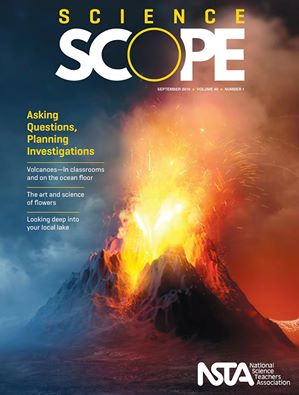Online Courses: MSU National Teachers Enhancement Network: Plant Science: It Grows on You
A love note to education conferences
By Peggy Ashbrook
Posted on 2017-01-26
 In my suitcase I have a collapsible jug, tube, funnel, glitter, pebbles, foam hearts, sea shells, and empty plastic bottles—all part of the materials I need for a presentation at the 2017 ECSTEM conference (February 3-4), organized by The Children’s Center at Caltech, in collaboration with THINK Together.
In my suitcase I have a collapsible jug, tube, funnel, glitter, pebbles, foam hearts, sea shells, and empty plastic bottles—all part of the materials I need for a presentation at the 2017 ECSTEM conference (February 3-4), organized by The Children’s Center at Caltech, in collaboration with THINK Together.
 An education conference is a joyful place where people are seriously planning to help children develop into critical thinkers, future leaders and life-long learners, as well as learn skills and content matter. This kind of professional development connects people who have experience and want discussion around their topic with people who want to learn about it. And it connects education researchers with people who are teachers so their conversation can be mutually beneficial. These connections can extend beyond the conferences and become resources for each of us. Conferences expose us to regional differences in schools, programs and culture, and to the many, many vendors that sell to the education community. Being at a conference as it unfolds gives us new appreciation for our education associations and organizations, for their ability to build a system that can meet many of the needs of a community that is so diverse. I know a conference was time well spent when I feel part of a group that wants a good future for all children; when I’ve learned some new science content; gained insight into how children learn, how adults learn, and how schools can become better at supporting science learning; and have resources and connections to colleagues who I can turn to with questions.
An education conference is a joyful place where people are seriously planning to help children develop into critical thinkers, future leaders and life-long learners, as well as learn skills and content matter. This kind of professional development connects people who have experience and want discussion around their topic with people who want to learn about it. And it connects education researchers with people who are teachers so their conversation can be mutually beneficial. These connections can extend beyond the conferences and become resources for each of us. Conferences expose us to regional differences in schools, programs and culture, and to the many, many vendors that sell to the education community. Being at a conference as it unfolds gives us new appreciation for our education associations and organizations, for their ability to build a system that can meet many of the needs of a community that is so diverse. I know a conference was time well spent when I feel part of a group that wants a good future for all children; when I’ve learned some new science content; gained insight into how children learn, how adults learn, and how schools can become better at supporting science learning; and have resources and connections to colleagues who I can turn to with questions.
 A science education conference is a place for early childhood educators and an early childhood education conference is a place for science educators. We have to show up and contribute to create the conference experience that will benefit our teaching practice and our students. Having a colleague work with me at my first conference presentation (using an overhead projector to share photos of children at work in a science exploration) made this first experience less daunting. Those of us who have been in the profession for longer can partner with newer educators to support their first presentation experience as we learn from them. Any who are able can donate to scholarship programs that pay for conference registrations, housing and travel for those whose programs can’t pay these expenses.
A science education conference is a place for early childhood educators and an early childhood education conference is a place for science educators. We have to show up and contribute to create the conference experience that will benefit our teaching practice and our students. Having a colleague work with me at my first conference presentation (using an overhead projector to share photos of children at work in a science exploration) made this first experience less daunting. Those of us who have been in the profession for longer can partner with newer educators to support their first presentation experience as we learn from them. Any who are able can donate to scholarship programs that pay for conference registrations, housing and travel for those whose programs can’t pay these expenses.
I’m looking forward to the 2017 NSTA national conference in Los Angeles where I’ll participate in the amazing Elementary Extravaganza event and take in as many other sessions as I can! Early bird registration deadline is February 3!
What local, regional, state, or national conference do you recommend?
 In my suitcase I have a collapsible jug, tube, funnel, glitter, pebbles, foam hearts, sea shells, and empty plastic bottles—all part of the materials I need for a presentation at the 2017 ECSTEM conference (February 3-4), organized by The Children’s Center at Caltech
In my suitcase I have a collapsible jug, tube, funnel, glitter, pebbles, foam hearts, sea shells, and empty plastic bottles—all part of the materials I need for a presentation at the 2017 ECSTEM conference (February 3-4), organized by The Children’s Center at Caltech
Writing in Science
By Mary Bigelow
Posted on 2017-01-25
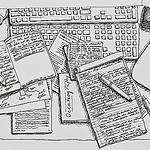 I’m looking for ideas to incorporate writing into my general biology classes. I’ve tried term papers but many of my students struggled and it took a lot of class time. Any ideas for other relevant writing assignments? —V., Ohio
I’m looking for ideas to incorporate writing into my general biology classes. I’ve tried term papers but many of my students struggled and it took a lot of class time. Any ideas for other relevant writing assignments? —V., Ohio
Writing in science has alternatives to traditional term papers or reports. Rather than making a formal writing project an “event” in class, it might be beneficial for students to experience how communicating information is an everyday science practice (as described in the Next Generation Science Standards).
A museum herpetologist told a group of teachers that although his research focused on snakes in their environments, a good portion of his time was spent writing—notes, memos, observations, summaries, reports, journal articles, blog entries, and letters. So if you have students write lab reports, make journal entries, summarize their learning, contribute to a class blog, take their own notes, or respond to open-ended items on an assessment, you’re already helping students with the focused type of writing used in science and engineering.
You can’t assume that students have the writing skills they need (especially for a term paper or formal report). You can teach students about writing, but the best way to develop skills is to have them write through planned and purposeful activities in class. Modeling is essential. Show students what effective science writing looks like (incorporating both words and graphics). Show them examples of ineffective writing and ask them to clarify it. Do a “think-aloud” as you write along with the students. Show them the value of text structures such as bulleted or numbered lists, headings, or tables.
When students display or share their writing in the classroom or with the community through a webpage or other publications, having an authentic audience adds another dimension of relevancy.
Go Wireless® Heart Rate
By Edwin P. Christmann
Posted on 2017-01-24
Introduction
When studying the cardiovascular system, Vernier’s Go Wireless® Heart Rate monitor is an excellent way for students to engage in the collection of real data by having the opportunity to monitor their heart rates in a variety of ways. For example, students can take their pulse before, during, and after exercising. While doing so, the data is being collected and transmitted wirelessly through a Bluetooth sensor via a free “App” for either an Android or iOS device. Once downloaded, students can use the Graphical Analysis App to wirelessly collect, analyze, and share data collected from the sensor. Hence, students can do real-time graphs from the experimental data that can enhance their work and lab reports with easy annotations, statistics, and curve fits.
How does it work?
First, it is worth emphasizing that the Vernier’s Go Wireless® Heart Rate monitor is an incredibly user-friendly device. To get started, the first step before beginning an experiment is to download the Graphical Analysis App, which is compatible for iOS devices (version 2.2 or newer) at the App Store and Android devices (version 2.1 or newer).

Once the download is complete, there are two separate components of interest: 1) the Heart Rate Hand Grips and 2) the Polar Transmitter Module (battery included). After you connect the Polar Transmitter Module, it detects each electrical signal from the heart from the electrodes on the hand grips. Subsequently, while holding the hand grips, the heart rate data is transmitted wirelessly to your mobile device. Since each device has a unique ID located on the side of the Polar Transmitter Module, by opening the Graphical Analysis App, you can identify the correct ID and proceed to analyze your data.
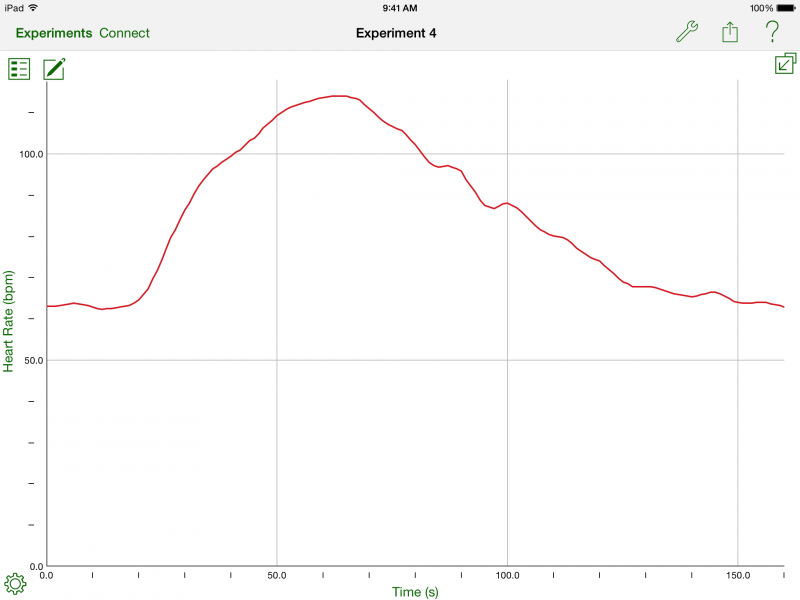
Because the data is collected in real time, the students can see the data being collected, which gives them an opportunity to examine how their physical activity levels affect pulse rate variations. Here are some examples of science activities that can be used with Vernier’s Go Wireless® Heart Rate monitor:
Heart Rate and Exercise: https://www.vernier.com/files/sample_labs/HP-A-04-COMP-heart_rate_exercise.pdf
Heart Rate and Blood Pressure as Vital Signs: https://www.vernier.com/files/sample_labs/HP-A-10-COMP-heart_rate_bp.pdf
Effect of Coughing on Heart Rate: https://www.vernier.com/files/sample_labs/HP-A-06-COMP-effect_of_coughing.pdf
Conclusion
Vernier’s Go Wireless® Heart Rate monitor is an exciting new tool to explore heart rate in the science classroom. Undoubtedly, it will give students a conceptual understanding of how different levels of exercise intensity can change heart rate variations and will also challenge your students to get out of their seats and enjoy this user friendly scientific device for meaningful learning. If you are looking for a way to maximize your students’ interest in learning about heart rate; Vernier’s Go Wireless® Heart Rate monitor is an excellent tool for meeting the instructional objectives.
Cost: $89
Product Site: https://www.vernier.com/products/sensors/heart-rate-sensors/gw-hr/
User Manual: https://www.vernier.com/files/manuals/gw-hr.pdf
Edwin P. Christmann is a professor and chairman of the secondary education department and graduate coordinator of the mathematics and science teaching program at Slippery Rock University in Slippery Rock, Pennsylvania. Anthony Balos is a graduate student and a research assistant in the secondary education program at Slippery Rock University in Slippery Rock, Pennsylvania.
Introduction
Science 2.0: Help Students Become Innovative Designers
By sstuckey
Posted on 2017-01-23
Our past three columns described how teachers can implement the first three Empowered Learner Standards established by the International Society for Technology in Education (ISTE). This month, we focus on classroom strategies to support the fourth standard: Innovative Designer.
The performance indicators in the Innovative Designer standard align with the practices of scientific inquiry, which help students conduct scientific investigations. Students become innovative designers once they meet these performance indicators:
- know and use a deliberate design process for generating ideas, testing theories, creating innovative artifacts or solving authentic problems;
- select and use digital tools to plan and manage a design process that considers design constraints and calculated risks;
- develop, test, and refine prototypes as part of a cyclical design process; and
- exhibit a tolerance for ambiguity, perseverance, and the capacity to work with open-ended problems (ISTE 2016). (italics added)
It’s worth noting that only the second performance indicator, where students plan and manage the design process, actually requires using technology. For this indicator, digital mapping tools (e.g., Lucidchart, MindMap) work well.
Defining innovation
Innovation implies that students must come up with something new or original and is often associated with great improvements to the way of life. This is a paradigm that science teachers must shift.
Accomplishments by companies such as Tesla or Apple are the exception, not the norm, and may only serve as a form of inspiration. Teachers should encourage students to be motivated by their successes and learn from their practices, but we must establish a classroom culture and norms that allow students to experience innovation in their own right.
Simplifying innovation
Tony Wagner, author of Creating Innovators, makes the compelling argument that innovation is really just the act of creative problem solving. To foster this type of behavior, he says, a classroom must promote passion, play, and purpose. Creating a classroom culture that grows innovative designers should therefore be examined through the lens of these “three Ps.”
However, not all activities need to promote this definition of innovation. Traditional types of activities are often the necessary foundation for students to learn scientific investigation. Students should still follow prescribed steps that allow them to learn measurement, instrumentation, and observation. However, once students become proficient in these skills, they should begin to choose their own learning path to foster the three Ps.
Science classroom innovation
When students explore their passions and are given the opportunity to find authentic problems with purpose, students will find that their work feels more like play. The timeless quote by Ray Bradbury, “Love what you do, do what you love…” could never be more applicable as when students find passion and purpose in their work.
Teachers can begin activities with simple questions, “Tell us what waves do?” “Show us how a chemical reaction works.” and “Is our local stream healthy?” Although such questions are derived from traditional activities, students can take ownership of each question when they choose their path and add purpose to their work. Finally, students also need to develop a tenacious approach to these problems so they demonstrate grit. When that happens, we begin to see innovation.
Ben Smith (ben@edtechinnovators.com) is an educational technology program specialist, and Jared Mader (jared@edtechinnovators.com) is the director of educational technology, for the Lincoln Intermediate Unit in New Oxford, Pennsylvania. They conduct teacher workshops on technology in the classroom nationwide.
Reference
International Society for Technology in Education (ISTE). 2016. The 2016 ISTE standards for students. Arlington, VA: ISTE. http://bit.ly/ISTE-standards
Editor’s Note
This article was originally published in the January 2017 issue of The 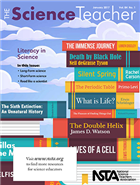 Science Teacher journal from the National Science Teachers Association (NSTA).
Science Teacher journal from the National Science Teachers Association (NSTA).
Get Involved With NSTA!
Join NSTA today and receive The Science Teacher,
the peer-reviewed journal just for high school teachers; to write for the journal, see our Author Guidelines, Call for Papers, and annotated sample manuscript; connect on the high school level science teaching list (members can sign up on the list server); or consider joining your peers at future NSTA conferences.
Our past three columns described how teachers can implement the first three Empowered Learner Standards established by the International Society for Technology in Education (ISTE). This month, we focus on classroom strategies to support the fourth standard: Innovative Designer.
Ideas and inspiration from NSTA’s K-12 journals–January 2017
By Mary Bigelow
Posted on 2017-01-22
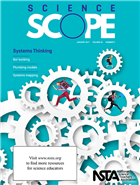 Science Scope – Systems Thinking
Science Scope – Systems Thinking
The articles this month provide “examples of how to integrate the crosscutting concept of systems and system models” into the classroom. (From the Editor’s Desk: Systems Thinking Solutions) Featured articles that describe lessons include a helpful sidebar (“At a Glance”) documenting the big idea, essential pre-knowledge, time, and cost.
The lessons also include connections with the NGSS.
- Although students may be familiar with the term “system,” the authors of Using Systems Mapping to Plan Scientific Investigations and Integrating Technology: Students Making Systems Models: An Accessible Approach describe how to help them learn about system components and provide examples of systems mapping and modeling in several content areas.
- Students get hands-on experience in Building Bots to Develop Systems Thinking.
- Diving Into Buoyancy describes how designing, building, and testing submarines can help to correct misconceptions about sinking and floating.
- In Call the Plumber! Engaging Students With Authentic Engineering Design Practices, students incorporate the design process, online simulations, and physical models to solve a problem.
- Students explore gravity and why objects “fall” in this Classic Lessons 2.0: Falling Into Understanding with a probe for understanding, a 5E lesson, data tables, and examples of student work.
- Citizen Science: Ecosystems and Eagle Populations describes a yearly project that monitors populations. The article includes other year-round resources and how to access the data.
- Disequilibrium: A Balancing Act includes a 5E lesson on how students can study the relationships between components of a system.
- Find ideas from other teachers in this month’s Listserv Roundup: From the Archives: Systems.
- Teacher to Teacher: Assessing Crosscutting Concepts and Teacher’s Toolkit: Using Rubrics to Integrate Crosscutting Concepts have ideas to help students focus on these concepts.
- Scope on the Skies: Flipped Constellations describes systems of stars.
For more on the content that provides a context for these projects and strategies see the SciLinks topics Buoyancy, Constellations, Ecosystems, Equilibrium, Fluids and Pressure, Force of Gravity, Galileo, Gravity, Matter and Energy, Newton’s Laws of Motion, Robots, Submarines and Undersea Technology, Systems
Continue for Science and Children, The Science Teacher
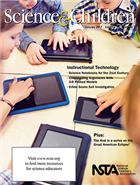 Science & Children – Instructional Technology
Science & Children – Instructional Technology
In the classroom we’ve been incorporating technology since the 1980s and 90s. The Editor’s Note: The Dilemmas of Technology describes somequestions we continually need to address. We may never have the answers, as technology changes rapidly!
The lessons described in the articles include a graphic showing connections with the NGSS.
- Students are involved in Constructing Arguments With 3-D Printed Models as they design and use models to investigate the adaptations of bottom-dwelling fish (including photos of student work and suggestions for 3-D printing in the classroom).
- Crime Scene Soil Investigation turns students in scientific detectives as they use mobile learning technologies (e.g., tablets with microscope attachments, probes) to collect and analyze soil samples. The authors include photographs and teaching suggestions.
- There can be more to gardening than planting seeds! Zooming in on Science
- Students learning with technology rather than from technology? Science Notebooks for the 21st Century examines the use of electronic notebooking applications as tools for learning.
- Mark August 21, 2017, on your calendar. Here are some suggestions to Get Ready for the Great American Eclipse!
- The ideas in What’s Lurking in Our Lake? uses the DIY Lake Science app to collect and analyze data. The concepts could be applied to a study of any body of water near your school.
- Writing poems about inventions? The Poetry of Science: Think It, Build It, Make It has an example of how scientists use technology to solve problems.
- The Early Years: Integrating Digital Tools summarizes position statements on the appropriate use of digital tools with PreK-2 students, with an ongoing lesson idea on using different technologies to send messages.
- Teaching Through Trade Books: Teaming Up: Trade Books and Technology provides two lessons in which students use technology to find information or show their understanding of how animals adapt for survival.
- Engineering Encounters: Optimizing Your K–5 Engineering Design Challenge and Methods and Strategies: Using Argument-Based Inquiry Strategies for STEM Infused Science Teaching have ideas for STEM-related activities, engineering design, and argumentation.
- Zooming In on Science illustrates how enhanced photography (GigaPan) can add to garden-based learning.
For more on the content that provides a context for these projects and strategies see the SciLinks topics Adaptations, Adaptations of Animals, Body Systems, Bridge Structures, Catapults, Eclipses, Explore Soil, Forensic Science, Inventions/Inventors, Plant Growth, Rockets, Soil Types, Sound, Waves, Watersheds
 The Science Teacher — Literacy in Science
The Science Teacher — Literacy in Science
The featured articles in this issue offer tips and techniques for engaging science students in reading critically and writing clearly. Note: These ideas are also appropriate for middle school.
The lessons described in the articles include connections with the NGSS.
- Help students learn to Read Like a Scientist with strategies for popular texts (generating interest), textbooks (finding information), and primary sources (investigations and arguments).
- Long-Form Science has suggestions for how to incorporate nonfiction texts into science topics with before-during-after reading strategies.
- If you’ve wondered what “close reading” is, Short-Form Science illustrates how to blend reading of challenging text with other instructional methods. A list of readings is included.
- English Language Learners can become more Text Savvy with the suggestions from these authors on selecting and using text and guiding students through the reading.
- The Green Room: The Top Five Environmental Stories of 2016 has links to readings on these topics.
- Focus on Physics: When What You See Is What You Hear has a basic discussion of the science of sound and acoustics.
- Looking ways to encourage students to write? See this month’s Idea Bank: Keep Current With a Journal Club with suggestions for readings.
- Show students how to combine passions in writing and science with Career of the Month: Television Writer.
- Right to the Source: Why Scientists Write has links to primary sources for Alexander Graham Bell’s writing as a example.
For more on the content that provides a context for these projects and strategies see the SciLinks topics Acoustics, Asexual Reproduction, Atomic Structure, Modern Atomic Theory, Climate Change, Marine Ecosystems, Meiosis, Mitosis, Mutations, Renewable Resources, Sound Reflection
 Science Scope – Systems Thinking
Science Scope – Systems Thinking
What Are the National Academies and How Can You Use Them to Transform Your Teaching?
By Guest Blogger
Posted on 2017-01-17
During Recognition Week for the 2006 Presidential Award for Excellence in Mathematics and Science Teaching, awardees gathered in a Washington, DC, hotel for a federal agencies breakfast. While all 10 agencies present that morning provided awardees with an overview of their educational programs and outreach opportunities, it was The National Academies’ information that especially appealed to my desire to translate educational research into practice. I learned how The National Academies advances and fosters an awareness of the best cutting-edge science and its use in programs and reports. Unlike other Academies in many other countries, the U.S. Academies are not an arm of the federal government. The National Academies are a private, non-profit organization that depends on grants and contracts to support their work.
Later during Recognition Week, I received a copy of Taking Science to School, a consensus report from The National Academies during one of the professional development sessions. Besides the National Science Education Standards, this book was my first in depth exposure to a National Academies evidence-based consensus report. Upon receiving the report, a summary of major findings and conclusions was provided by one of the reports committee members. It was during this professional development session that I became aware of the four strands of science learning. (See October 2016 Science Scope for related article).
As I began thumbing through the table of contents and previewing chapters, I was drawn to the quote from Henri Poincare at the beginning of chapter 2, which states: “Science is built up of facts as a house is of stones, but a collection of facts is no more a science than a pile of stones is a house.” I was captivated by a subtitle on the same page, What is Science? and thought, since I was invited to Washington because of science teaching, I should read this section! I was perplexed however, when reading this section because my beliefs were challenged about the scientific method, an approach I had embraced in my teaching for years. I even had a poster in my classroom which described the method steps for direct experimentation. Upon additional reading, I learned this method treats science as a series of disembodied skills and fails to develop meaningful understanding. That feeling of cognitive dissonance and deeper reflection on practice has often led to an alteration of classroom behavior.
This new perspective in my thinking about some of the most tightly held and accepted premises of STEM and education that resulted from this report are typical of the findings, conclusions, and recommendations that emerge from National Academies’ consensus reports and publications from public workshops, symposia, and convocations. Founded in 1863 by an Act of Congress, The National Academies has served as an advisor to the nation on all matters of science, engineering, technology, and medicine. The original organization consisted of The National Academy of Sciences, but has since grown to now include The National Academies of Engineering and Medicine. The Academies are both honorific, where members elect other members who are recognized for lifetime achievement in these fields (most of the American Nobel Laureates named each year are members of one or more of the Academies), and they oversee the work of advising the nation. Additional details about how the Academies carry out their mission and work can be found here.
As a result of a clause in the original charter, all of the people who serve on The National Academies committees, prepare reports, and oversee the organization of workshops and symposia are volunteers, committing anywhere from six months to two years (depending on the project) in service to the American people. Each year approximately 6000 volunteers serve on some 500 to 600 ad hoc and permanent committees. The Academies publish about 250 reports each year, all available for free downloading at the website National Academies Press (http:/nap.edu). Visitors to this website also can sign up to receive notices about newly released reports in any area(s) of interest. A number of publications have been prepared for teacher practitioners. For example, the publication Taking Science to School also led to a practitioner volume for elementary and middle school teachers, Ready, Set, Science!: Putting Research to Work in K-8 Science Classrooms (available for free download here).
Since that breakfast a decade ago, I have relied on consensus reports from The National Academies to inform and guide my teaching. Turning to the National Academies for trusted advice based upon evidence, is now a natural part of my teaching practice. Other education-focused reports of The National Academies you may find meaningful in your work are:
- A Framework for K-12 Science Education: Practices, Crosscutting Concepts, and Core Ideas
- Developing Assessments for the Next Generation Science Standards
- STEM Integration in K-12 Education: Status, Prospects, and an Agenda for Research
- Monitoring Progress Toward Successful K-12 STEM Education: A Nation Advancing?
Author Kenneth L. Huff (khuff@ williamsvillek12.org) is the NSTA Division Director, Middle Level Science Teaching; a science educator at Mill Middle School in Williamsville, New York; and Vice Chair of The National Academies’ Teacher Advisory Council (http://nas.edu/tac).
Join NSTA today and receive Science Scope, the peer-reviewed journal just for middle school teachers; connect on the middle level science teaching list (members can sign up on the list server); or consider joining your peers for Meet Me in the Middle Day (MMITM) at the National Conference on Science Education in Los Angeles in the spring of 2017.
The mission of NSTA is to promote excellence and innovation in science teaching and learning for all.
Future NSTA Conferences
-
2017 National Conference
2017 STEM Forum & Expo
2017 Area Conferences
Follow NSTA
- Read more about What Are the National Academies and How Can You Use Them to Transform Your Teaching?
During Recognition Week for the 2006 Presidential Award for Excellence in Mathematics and Science Teaching, awardees gathered in a Washington, DC, hotel for a federal agencies breakfast. While all 10 agencies present that morning provided awardees with an overview of their educational programs and outreach opportunities, it was The National Academies’ information that especially appealed to my desire to translate educational research into practice. I learned how The National Academies advances and fosters an awareness of the best cutting-edge science and its use in programs and
Here's Why Space Nerds Need to Be at #NSTA17 LA
By Lauren Jonas, NSTA Assistant Executive Director
Posted on 2017-01-16
We didn’t invent the term space nerds; we just invited the two most interesting people on the planet who are proud to own it to speak at NSTA’s 2017 National Conference in Los Angeles: March 30–April 2.
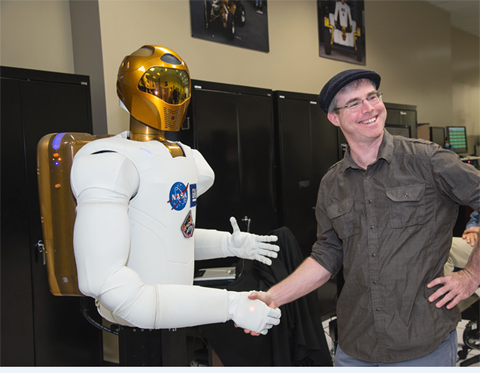
15 Early Birds Get to Dine With Andy Weir
Our keynote speaker is Andy Weir, author of the New York Times best seller The Martian, and a lifelong space nerd and devoted hobbyist of subjects like relativistic physics, orbital mechanics, and the history of manned spaceflight. Join us in LA to hear Weir speak on Thursday, March 30, from 9:15–10:30 AM.
Register by the earlybird deadline, February 3, and you’ll be automatically entered for a chance to win a special VIP experience. Fifteen lucky winners will receive:
- Invitation to join Andy for an exclusive dinner on Wednesday evening hosted by Penguin Random House
- Complimentary copy of the book and classroom kit
- VIP seating at the General Session
Special Preconference Presentation by Bill Nye
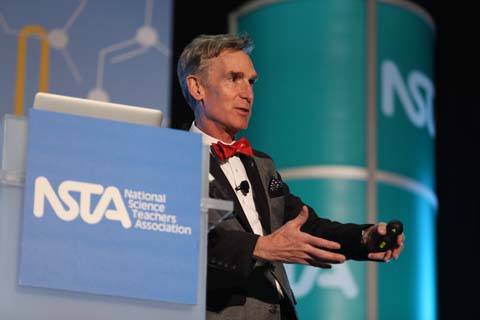
Don’t miss scientist, comedian, teacher, and author—Bill Nye as he shares “How nerds solve problems.” Bill’s ongoing mission is to change the world through science education. Join us to hear Bill’s Planetary Society Lecture on Wednesday, March 29, from 6:00–8:00 PM.
Meet Your Favorite NSTA Press Authors!
NSTA Press® Session: Argumentation in the Earth and Space Science Classroom
Thursday, March 30 8:00 AM – 9:00 AM
JW Marriott Los Angeles at L.A. LIVE, Diamond Ballroom Salon 3
Join us for a hands-on workshop to learn how to engage in scientific argumentation to support teaching in your classrooms. Sample activities from the leading NSTA books provided.
Presenter(s): Sharon Schleigh (East Carolina University: Greenville, NC)
FORMAT: Hands-On Workshop
GRADE LEVEL: 5 – 12
SUBJECT: Earth and Space Science
NSTA Press® Session: Next Time You See…
Friday, March 31 12:30 PM – 1:30 PM
JW Marriott Los Angeles at L.A. LIVE, Diamond Ballroom Salon 3
The author of the Next Time You See series from NSTA Press will share books and activities to inspire a sense of wonder about the natural world.
Presenter(s): Emily Morgan (Picture-Perfect Science: West Chester, OH)
FORMAT: Hands-On Workshop
GRADE LEVEL: PreK, K, 1 – 5
SUBJECT: General Science Education
NSTA Press® Session: Learning to Read the Earth and Sky, Explorations Supporting the NGSS
Friday, March 31 2:00 PM – 3:00 PM
JW Marriott Los Angeles at L.A. LIVE, Diamond Ballroom Salon 3
Earth scientists read stories written in the Earth. Join us in some investigative classroom lessons through which you and your students can apply the practices of science to reading the Earth.
Presenter(s): Russell Colson (Minnesota State University Moorhead: Moorhead, MN), Mary Colson (Horizon Middle School: Moorhead, MN)
FORMAT: Hands-On Workshop
GRADE LEVEL: 6 – 12, College
SUBJECT: Earth and Space Science
NSTA Press® Session: Solar Science = NGSS-Focused Solar Astronomy Experiences + Preparation for the All American Total Solar Eclipse
Saturday, April 1 9:30 AM – 10:30 AM
JW Marriott Los Angeles at L.A. LIVE, Diamond Ballroom Salon 3
NSTA recently published Solar Science, a solar astronomy curriculum resource that is NGSS-focused and prepares you for the 2017 solar eclipse. Come explore some of these effective learning experiences.
Presenter(s): Dennis Schatz (Pacific Science Center: Seattle, WA), Andrew Fraknoi (Foothill College: Los Altos Hills, CA)
FORMAT: Hands-On Workshop
GRADE LEVEL: 5 – 9
SUBJECT: Earth and Space Science
Out of This World Sessions, Trips, and Workshops
What else can Earth and space science fans do at NSTA’s National Conference? Here’s a sample; search the online session browser for more.
Blue Marble Matches
Thursday, March 30 8:00 AM – 9:00 AM
Los Angeles Convention Center, Kentia Hall Q
Connect NASA images of Earth and other planets with the evidence for geologic processes like weathering and erosion, while exploring the processes shaping our worlds.
Presenter(s): Veronica Leija (Learning Expert: Houston, TX), Brandon Hargis (NASA Johnson Space Center/Texas State University: Houston, TX)
FORMAT: Hands-On Workshop
GRADE LEVEL: 6 – 8
SUBJECT: Earth and Space Science
T-1: NASA Jet Propulsion Laboratory Morning Tour
Thursday, March 30 8:30 AM – 12:45 PM
Off-site, NASA Jet Propulsion Laboratory
T-3: NASA Jet Propulsion Laboratory Afternoon Tour
Thursday, March 30 12:00 PM – 4:15 PM
Off-site, NASA Jet Propulsion Laboratory (PM)
Ticket Price: $35 advance, preregistration only
Purchase tickets when you register online or on the LA Registration Form.
T-6: Griffith Observatory: Gateway to the Cosmos
Thursday, March 30 6:00 PM – 10:45 PM
Off-site, Griffith Observatory
Ticket Price: $35 advance; $40 on-site
Purchase tickets when you register online or on the LA Registration Form.
NASA’s “Eyes on the Solar System”: Bringing the Planets to Your Classroom
Friday, March 31 8:00 AM – 9:00 AM
Los Angeles Convention Center, Kentia Hall P
Bring the solar system to your classroom using this free computer-based model from NASA. Explore planets, spacecraft, and more!
Presenter(s): Rachel Zimmerman Brachman (NASA Jet Propulsion Laboratory: Pasadena, CA), Kevin Hussey (NASA Jet Propulsion Laboratory: Pasadena, CA)
FORMAT: Presentation
GRADE LEVEL: 5 – 12
SUBJECT: Earth and Space Science
F-1: Science and Endeavour Up Close at California Science Center
Friday, March 31 9:00 AM – 1:15 PM
Off-site, California Science Center
Ticket Price: $29 advance; $34 on-site
Purchase tickets when you register online or on the LA Registration Form.
F-2: The Columbia Memorial Space Center: Exploring 21st-Century STEM at a Historic NASA Site
Friday, March 31 9:30 AM – 1:30 PM
Off-site, Columbia Memorial Space Center
Ticket Price: $31 advance; $36 on-site
Purchase tickets when you register online or on the LA Registration Form.
Rocket Science and Engineering in High School: A STEM Approach
Friday, March 31 11:00 AM – 12:00 PM
JW Marriott Los Angeles at L.A. LIVE, Diamond Ballroom Salon 9
Come learn how to adapt complex concepts of aerospace engineering to high school students, in a hands-on STEM program.
Presenter(s): Dimitri Scripnic (Florida Polytechnic University: Lakeland, FL), Roberto Silva (Technological Institute of Aeronautics: Vila das Acacias, SP, Brazil)
FORMAT: Hands-On Workshop
GRADE LEVEL: 8 – 12, College
SUBJECT: Engineering-Technology-and the Application of Science, Earth and Space Science
Friday, March 31 2:00 PM – 3:00 PM
Los Angeles Convention Center, Kentia Hall P
Come learn how students in Washington State were able to work with scientists from a NASA Earth-observing mission to help with ground validation campaign!
Presenter(s): Dorian Janney (NASA Goddard Space Flight Center: Greenbelt, MD)
FORMAT: Presentation
GRADE LEVEL: 7 – 12
SUBJECT: Engineering-Technology-and the Application of Science, Earth and Space Science
STEM on Station
Friday, March 31 3:30 PM – 4:30 PM
JW Marriott Los Angeles at L.A. LIVE, Diamond Ballroom Salon 8
NASA Education Specialists demonstrate how to integrate research from the International Space Station into the biology classroom.
Presenter(s): Crystal Del Rosso (Paragon TEC: Houston, TX), Brandon Hargis (NASA Johnson Space Center/Texas State University: Houston, TX)
FORMAT: Hands-On Workshop
GRADE LEVEL: 7
SUBJECT: Life Science
Space Explorers: 25 Years of Inner-City Students Out-of-School-Time Explorations
Friday, March 31 5:30 PM – 6:00 PM
Los Angeles Convention Center, Kentia Hall R
Discover how to measure the universe with a digital camera and a Godzilla model, how fast your rods are compared to your cones in your eyes, and what happens when you connect astronomers and inner-city high school students.
Presenter(s): Randall Landsberg (Kavli Institute for Cosmological Physics: Chicago, IL)
FORMAT: Presentation
GRADE LEVEL: 7 – 12
SUBJECT: Informal Science Education, Earth and Space Science
NESTA and NSTA Aerospace Education Advisory Board Space Science Share-a-Thon
Saturday, April 1 8:00 AM – 9:00 AM
Los Angeles Convention Center, Petree Hall D
Join more than 20 NESTA members and other education specialists as they share their favorite NGSS-congruent classroom activities. Lots of free handouts!
Presenter(s): Paul Nordhaus (Harborside Academy: Kenosha, WI), Carla McAuliffe (TERC: Cambridge, MA)
FORMAT: Hands-On Workshop
SUBJECT: Earth and Space Science
Wonderful Watersheds!
Saturday, April 1 9:30 AM – 10:30 AM
JW Marriott Los Angeles at L.A. LIVE, Plaza 3
Get background on the science behind watershed regions and learn how NASA satellites collect data to better understand and protect these essential environments.
Presenter(s): Dorian Janney (NASA Goddard Space Flight Center: Greenbelt, MD)
FORMAT: Presentation
GRADE LEVEL: 2 – 12
SUBJECT: Life Science, Engineering-Technology-and the Application of Science, Earth and Space Science
Destination: NASA…21st-Century Skills and STEAM
Saturday, April 1 9:30 AM – 10:30 AM
Los Angeles Convention Center, Kentia Hall G
Join us and use NASA resources to collaboratively plan and implement integrated multidisciplinary units for K–5, like the one we’ll share “Destination: International Space Station!”
Presenter(s): Margaret Duke (Forest Lake Elementary School: Columbia, SC), Marian Scullion (Forest Lake Elementary School: Columbia, SC)
FORMAT: Hands-On Workshop
GRADE LEVEL: K, 1 – 5
SUBJECT: Earth and Space Science
Exploring Unknown Worlds Through Models, Images, and Data Analysis
Saturday, April 1 2:00 PM – 3:00 PM
Los Angeles Convention Center, Kentia Hall H
Explore an “unknown world” as a model for the way scientists explore planets, dwarf planets, moons, comets, and asteroids with telescopes and spacecraft.
Presenter(s): Larry Lebofsky (Planetary Science Institute: Tucson, AZ), Thea Canizo (Planetary Science Institute: Tucson, AZ), William Schmitt (The Science Center of Inquiry: Fountain Hills, AZ), Sanlyn Buxner (Planetary Science Institute: Tucson, AZ)
FORMAT: Hands-On Workshop
GRADE LEVEL: 3 – 8
SUBJECT: Earth and Space Science
 Want more? Browse the program preview, or check out more sessions and other events with the LA Session Browser/Personal Scheduler. Follow all our conference tweets using #NSTA17, and if you tweet, please feel free to tag us @NSTA so we see it! Need to request funding or time off? Download this letter of support.
Want more? Browse the program preview, or check out more sessions and other events with the LA Session Browser/Personal Scheduler. Follow all our conference tweets using #NSTA17, and if you tweet, please feel free to tag us @NSTA so we see it! Need to request funding or time off? Download this letter of support.
The mission of NSTA is to promote excellence and innovation in science teaching and learning for all.
Future NSTA Conferences
2017 National Conference
2017 STEM Forum & Expo
Follow NSTA
We didn’t invent the term space nerds; we just invited the two most interesting people on the planet who are proud to own it to speak at NSTA’s 2017 National Conference in Los Angeles: March 30–April 2.
Science classroom libraries
By Mary Bigelow
Posted on 2017-01-13
I am a new elementary librarian, and I want to prioritize science nonfiction. I’m looking for suggestions to help teachers who often do not have time to collect books from the library. I also n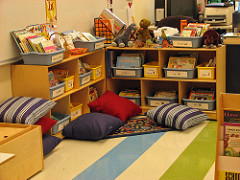 eed ideas for books to purchase. — J., New York
eed ideas for books to purchase. — J., New York
I spoke with a librarian colleague, who did what you are considering. She suggested asking teachers for a schedule of topics they work on throughout the year. She had a large plastic tub for each classroom where she put corresponding books covering a range of reading levels. For each unit, the classroom received a new set of supplementary books. She often had older students or parent volunteers prepare the boxes.
To find appropriate titles for all grade levels, I have used the NSTA website. Outstanding Science Trade Books for Students K–12 and the Best STEM Books K-12 contain lists compiled by NSTA in association with the Children’s Book Council. The titles are listed by year and include an annotated description of each book. NSTA Recommends also has monthly updates in the NSTA journals.
All of these titles are also in the second source, NSTA Recommends. This is a broader, searchable list that includes reviews of books and other media. The reviews are written by science educators and can be searched by format (e.g., print, kits, DVDs), keywords (e.g., weather, machines, insects), and grade level (K through college). The lists can be exported as Excel spreadsheets.
The School Library Journal also has a list of recommended Science and Nature Books for Kids.
Some teachers might be willing to help you select the books or suggest topics—perhaps during a faculty meeting or workshop on science and reading.
Photo: https://farm2.staticflickr.com/1033/1333506858_2f1392116d_m_d.jpg




